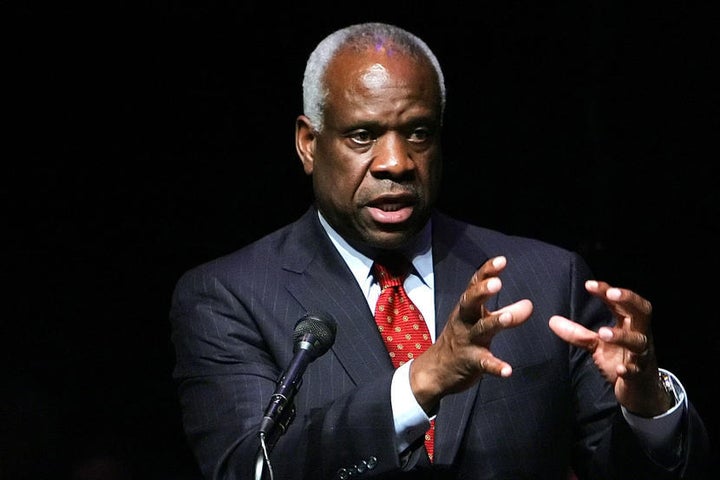
On Monday the Supreme Court struck down North Carolina’s race-based gerrymandering. To the surprise of many around the nation, long-time civil rights opponent, Justice Clarence Thomas joined the four liberal justices in a concurring opinion, rejecting that North Carolina had a compelling interest in using race to re-graph the district lines.
Though Slate’s Joseph Stein points out that this isn’t the first time Thomas joined the liberal justices of the court, this is particularly confusing to some given the court striking down a key component of the Voting Rights Act in 2013. Thomas, however, should not be seen as a champion of voting rights because even if his outcome aligned with the liberal justices of the court, his reasoning will continue to plague minority groups in future cases.
Section 2 of the Voting Rights Act forbids racial gerrymandering. When a citizen sues for violation of this law, she must prove that race was a predominant factor and if so, the state must show that the use of race was narrowly tailored to a compelling state interest. There is no doubt that North Carolina used race as a predominant factor. It conceded such. The question is whether it had the justification -- or compelling interest -- to do so. In her 36 page opinion, Justice Elena Kagan eloquently rejected the state’s claim that it used race to protect the future of the black vote. In two short pages, Justice Thomas acquiesced to the majority opinion while maintaining that the law it used should be overturned.
To understand his concurrence, one must understand the race-blind consistency of Thomas’ jurisprudence.
“In my view, [section] 2 does not apply to redistricting and therefore cannot justify a racial gerrymander,” Thomas writes, citing a 1994 case that appeared before the court under similar circumstances. In that case, Holder v. Hall, Thomas writes that the plain language of section 2 applies only to the access of the ballot. “Districting systems and electoral mechanisms that may affect the ‘weight’ given to a ballot duly cast and counted are simply beyond the purview of the Act,” Thomas writes.
This interpretation would only thwart antiquated obstructions such as poll taxes and not modern strategies -- such as packing minority neighborhoods together -- that would dilute voter power. In fact, in Holder, Thomas insisted that the case that gave rise to voter dilution be overturned. This would undoubtedly eliminate many civil rights activist’s efforts to redress voter discrimination.
“The statute was originally perceived as a remedial provision directed specifically at eradicating discriminatory practices that restricted blacks' ability to register and vote in the segregated South,” Thomas writes in Holder. “Now, the Act has grown into something entirely different. In construing the Act to cover claims of vote dilution, we have converted the Act into a device for regulating, rationing, and apportioning political power among racial and ethnic groups.”
As time advances so too do the tools used to corrupt civil rights. Voter dilution is meant to redress the modern tactics of suppression like the ones so prevalent in North Carolina a federal judge found that they “target[ed] African-Americans with almost surgical precision.”
North Carolina could legally use race to redraw the district lines if it is narrowly tailored with “good reason” to comply with Section 2. This would be legal if, for example, the state attempted to correct a minority group’s inability to choose its own representative because it is “submerg[ed] in a larger white voting population,” thereby being inhibited due to racially polarized voting.
However, Justice Kagan held that District 1’s history did not indicate an inability to choose its own representative nor was there reliable evidence that suggested it may have problems in the future. Therefore, North Carolina used race to redraw this district with the sole purpose of political subversion of the black vote. It used a requirement that was made to protect large voting blocs of minority groups from being overshadowed by the white, suppressive community as a pretext to further suppress the minority voting bloc.
Thomas’ rejection of Section 2’s application suggests that even if North Carolina actually tried to prevent voter suppression by using race, it should still be illegal.
This provision allows for a state to use race to redraw district lines in order to give agency to minority communities that may suffer from voter suppression. Justice Thomas’ ruling that District 1 was unconstitutional was more about his disbelief in using race in any law than an act of sudden civil rights heroism.
Thomas has remained consistent in his commitment to textualism at the expense of minority dignity. His opinion isn’t a sign of shifting views toward civility but a reaffirming indictment of his pledge to the laws of an America not designed to protect its most vulnerable citizens.
There are times that a tool that preserves evil destructs lesser forms of evil within its path. The holder should not be praised for his destruction but should be shamed for doing what is necessary to preserve.
